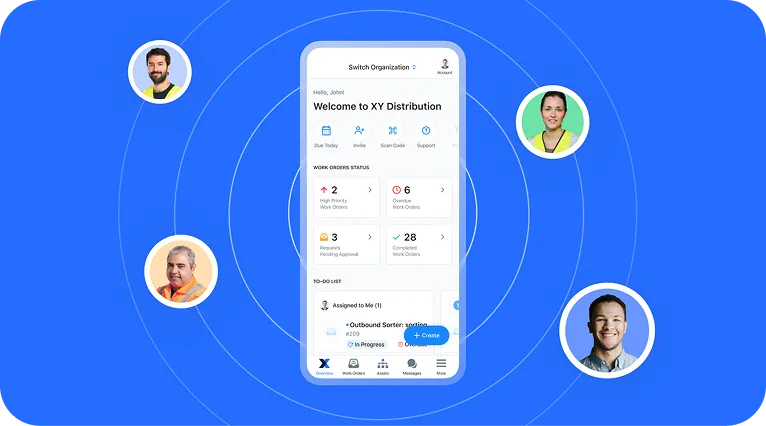
When done right, work orders keep teams on the same page, assets running, and compliance risks at bay. Done poorly, they can create confusion on your team that leads to backlogs and costly downtime.
Just an hour of unplanned downtime can cost your team $25,000 or more, so optimizing your work orders can be an effective way to control costs.
This guide breaks down everything you need to know to get and keep your work orders in good order, including: common questions and definitions, work order best practices, and how to get started with digital work order management.
Key takeaways
- Work orders are the backbone of effective maintenance and service operations.
- Standardization and prioritization help prevent backlogs and compliance risks.
- A digital work order management process delivers measurable gains in efficiency, safety, and cost savings.
What is a work order?
A work order is a document that authorizes, schedules, and tracks a task or job. It acts as the bridge between identifying a need and completing the work, whether it’s fixing equipment, performing preventive maintenance tasks, or managing facilities services.
Maintenance issues or service requests are often submitted using a work order request form, which formally documents and communicates the maintenance request to the maintenance team for review and approval.
Work orders help teams:
- Get clear on what needs to be done, when, and by whom
- Align stakeholders by documenting approvals, priorities, and safety instructions
- Stay compliant by keeping auditable records of maintenance and service activities
- Capture critical data to analyze labor, parts, costs, and asset performance
Traditionally handled with paper or spreadsheets, modern work orders are increasingly managed through work order management software or CMMS (Computerized Maintenance Management Systems). These tools streamline processes and improve data access by giving teams real-time visibility. Systems with mobile access allow teams to collaborate in real-time, reducing mistakes when logging information.
Work order vs. work request
While sometimes confused, the two are distinct:
- Work request: A submission (by staff, operators, or customers) indicating that a task is needed. Example: reporting a leaking pipe.
- Work order: The approved and authorized document that turns that request (or a scheduled task) into actionable work assigned to a technician.
Think of it as idea vs. action. The request raises a need; the work order makes sure the team gets it done.
Read: Work order vs purchase order
Why work orders matter
Well-structured work orders are the foundation for reliable operations. Benefits (including the following) show up across the entire organization:
- Efficiency: Clear instructions cut down on guesswork since technicians know exactly what needs to be done, when, and with which tools. Including all the details in each work order streamlines communication and management, reducing delays and keeping schedules on track.
- Compliance: Auditors don’t accept “I thought it was done.” Digital work orders provide a record of every inspection, repair, and safety check, helping organizations stay ahead of regulatory requirements. In fact, 82% of MaintainX customers agree that the software’s features, including work order management, have improved safety and streamlined compliance.
- Cost control: By tracking labor hours, parts, and materials in real time, leaders can spot trends, tighten budgets, and avoid costly last-minute fixes.
- Visibility: With every work order documented, maintenance managers can track KPIs like Mean Time to Repair (MTTR), completion rates, and backlog size. Work orders also help managers track progress on tasks, costs, and status updates, making it easier to identify bottlenecks before they become breakdowns.
- Safety: Detailed instructions and checklists make sure technicians don’t cut corners. From lockout-tagout procedures to hazard notes, work orders create a safer environment for frontline teams.
The stronger your work order process, the more confidence you’ll have in your ability to minimize downtime and protect your team.
Types of work orders and industry use cases
Work orders aren’t one-size-fits-all. Here’s how various industries put them into action depending on the job at hand:
- General work orders: These cover non-routine tasks such as painting, equipment setup, or moving assets. They’re common in facilities and property management.
- Preventive maintenance (PM) work orders: These are scheduled tasks designed to prevent breakdowns and extend asset life. They’re critical in manufacturing to reduce downtime and in facilities management to keep systems running smoothly.
- Inspection work orders: These ensure periodic checks on asset condition, often leading to corrective actions. They’re frequently used in manufacturing, property management, and facilities to stay ahead of issues.
- Corrective maintenance work orders: A corrective maintenance work order addresses existing equipment flaws or issues that are not emergencies. These are created when inspections or PMs uncover issues that require repair. They’re critical in manufacturing and hospitality, where reliability and customer experience are at stake.
- Emergency work orders: These are issued immediately when unexpected failures occur and downtime must be minimized. They’re used often in hospitality, where guest comfort is a priority, and in manufacturing, where production losses can be costly.
- Predictive maintenance work orders: These are triggered by sensors or analytics that forecast potential failures. Manufacturing facilities are increasingly using these as a way to improve Overall Equipment Effectiveness (OEE).
- Installation work orders: These document the process for installing new machinery, systems, or infrastructure. They are widely used in both manufacturing and facilities to ensure consistency and compliance during setup.
- Safety or hazard-specific work orders: These focus on tasks directly tied to worker safety and regulatory compliance. They are especially important in food & beverage to maintain sanitation standards and in facilities to meet building codes and safety requirements.
The work order lifecycle
Every work order follows steps designed to keep production running smoothly. Here’s an example of how a single job could move through this lifecycle:
- Identification: During a routine inspection on the production line, a technician notices that a conveyor motor is running hotter than usual. Left unresolved, it could cause an unexpected breakdown.
- Creation: The technician logs the issue in the CMMS, generating a work order. Because the conveyor is critical to production, the system automatically tags it as a high-priority job.
- Approval: A maintenance supervisor reviews the details, confirms the urgency, and approves the work order. With approval, the system adds the job to the maintenance schedule.
- Planning and scheduling: The scheduler assigns the task to a technician certified for electrical repairs, checks that the replacement bearings are in stock, and selects a time slot between production runs to minimize disruption.
- Execution: On the scheduled day, the technician shuts down the conveyor, replaces the worn bearings, and logs their work on a mobile device. They record the labor time, note the parts used, and attach a photo of the repair.
- Completion and documentation: The technician closes out the work order, and the system automatically stores a complete digital record. This makes the repair traceable for compliance audits and future reference.
- Analysis: When reviewing maintenance reports, the plant manager notices this conveyor has had repeated overheating issues. Based on the data, the team adjusts the preventive maintenance schedule to include more frequent bearing inspections.
Best practices for work order management
Consistency and clarity are key when it comes to getting the most from your work orders. Here are work order best practices that help maintenance teams stay efficient and in control:
Standardize your templates
Every order should capture the same key fields and balance detail with clarity. So what should teams include in a work order? At a minimum, you should outline:
- Work order number (unique identifier)
- Requester details (name, maintenance department, contact)
- Asset or location requiring service
- Description of work or issue
- Scope of work and instructions
- Assigned technician(s) or contractor(s)
- Priority level (high, medium, low)
- Safety requirements or notes
- Required parts, tools, and resources
- Estimated start and completion dates
- Estimated labor hours and costs
- Completion notes, photos, or attachments
- Sign-offs and approvals
Keep your forms consistent, but tailor fields to your industry’s needs (e.g., compliance data for food & beverage, hazard categories for manufacturing).
Browse free work order templates here.
Prioritize effectively
Not all maintenance tasks carry the same weight. A flickering light in a breakroom is not the same as a failing pump on a production line. Rank tasks by urgency and their impact on operations and safety. Clear prioritization prevents backlogs and ensures that high-risk issues are addressed first.
Automate triggers
Instead of relying on memory or manual scheduling, use software to auto-generate work orders based on time, usage, or condition. For example, a preventive maintenance work order could automatically trigger every 500 machine hours, or when a vibration sensor detects abnormal readings. Automation helps prevent missed work orders and reduces unplanned downtime.
Define roles and responsibilities
Confusion about who owns which part of the process leads to delays. Establish clear rules for who can create, approve, assign, and close work orders. In digital systems like MaintainX, permissions can be set so frontline staff submit requests, supervisors approve, and technicians close.
Conduct post-mortems
When major or repeated issues occur, don’t just close the book once the fix is done. Review the work order, root causes, and resolution to identify process improvements. For example, if the same motor fails repeatedly, a post-mortem might reveal the need for a design change, better parts, or an adjusted preventive maintenance schedule.
Consider mobile access
Field technicians are rarely at a desk. Giving them mobile access means they can update work orders in real time and log labor hours, attach photos, and check safety steps on the go. This saves time and improves data accuracy, which is critical for analysis and compliance reporting.
MaintainX’s mobile-first design and detailed work order requirements have helped a Cardinal Glass plant increase on-time work order completion by about 14% year-over-year. This is in part due to how the software minimizes back-and-forth trips, improving response times when equipment issues come up.
The role of work order management software
As the best practices above suggest, there are so many reasons for organizations to move toward a digital work order management system. Paper forms and spreadsheets just can’t keep up with today’s fast-moving operations.
For technicians, a digital system means less paperwork, quicker access to procedures, and the ability to update jobs in real-time from the field. For managers, it means better visibility, faster decisions, and more predictable results.
Ready to see how an asset and work order management platform like MaintainX can help your team work smarter? See real stories from our customers, or book a demo to walk through the features.
Work Order FAQs
What is the difference between a work order and a purchase order?
The main difference between a work order and a purchase order is that a work order authorizes internal tasks or services, while a purchase order is a formal request to buy goods or services from an external vendor. Work orders manage internal operations; purchase orders manage external procurement.
Can work orders be created automatically?
Yes, work orders can be created automatically using computerized maintenance management system (CMMS). These systems trigger work orders based on predefined conditions like equipment failure, scheduled maintenance, or sensor data, reducing manual input and improving operational efficiency.
How long should a work order stay open?
A work order should stay open only as long as required to complete the assigned task, typically 1 to 5 days for standard maintenance. Complex repairs may require a larger window, but keeping work orders open longer than necessary can delay reporting, billing, or follow-up actions.
Do small businesses need work order software?
Yes, small businesses can use work order software to streamline task management, track job status, and reduce errors. It improves communication, ensures timely completion, and creates a digital audit trail. Even with limited staff, automated work orders help maintain efficiency and accountability.








.webp)
.webp)
